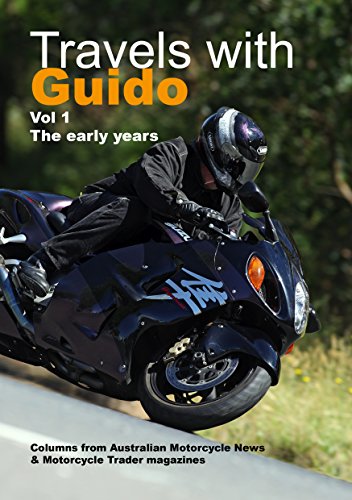Motorcycle Investor mag
Subscribe to our free email news

American sweetheart
Riding a 1947 Indian Chief
(Guy 'Guido' Allen, May 2025; pics
by David MacKenzie, Ben Galli & GA)

It's
often all too easy to dismiss older machinery as
outdated and incapable. However living with a 1940s
Indian Chief proved you need to be careful about
making judgements without the benefit of experience

We’re taking a big step back in time today, to 1941 and
through to 1953. The former date is when Indian
Motorcycles out of Springfield, Massachusetts in the
USA, first produced the distinctive deeply valanced
guards you see on this Chief.
Through
a lack of investment and innovation, the company turned
up its toes in 1953, to eventually be revived as an
ongoing concern in the 21st century.

What
you get with a classic Chief is a pre-war side-valve
engine which, in this 1947 example, displaces 1200cc. It
is in fact a strong performer and the bike will
comfortably hold a 70-75mph (110-120kph) cruising speed
– a solid number for the time.
However
arch-rival Harley-Davidson had Indian covered with its
own flathead engine, plus the far more advanced
overhead-valve Knucklehead from 1936. By 1947, it then
moved to the even more progressive Panhead.
That
left buyers with limited choices if they wanted
something that was mechanically up to date and made in
America.
Nevertheless
Indian
soldiered on with its outdated Chief, which did have its
virtues, such as solid reliability and respectable
performance.

Riding
one today is a great lesson in just how long Americans
have understood touring motorcycles. The comfort on a
1940s bike rivals some modern equivalents.
Suspension
up front is a springer, with dual coils and damper in
between. That was replaced by telescopic forks in 1950.
On the rear you have relatively primitive plunger
suspension, backed up by a well-sprung saddle. The total
effect, with a low seat and long wheelbase for the day,
is steady handling and a surprisingly smooth ride.

There
is some old technology to get your head around. Starting
is by kick, and the rider finds themselves juggling a
foot clutch with a hand-change for the three-speed crash
box. One twistgrip controls the throttle, while the
other adjusts the manual advance and retard for the
ignition.

Braking
is a mixed bag, with decent power on the rear, and a
fairly pathetic front. There are people out there making
twin leading shoe replacements that make a world of
difference.

Fuel
consumption is heavy – say about 11km/lt (30/26mpg
UK/USA). That, combined with a modest fuel capacity of
around 15lt (3.3/4.0 UK/US gallons), has led to an old
joke among owners that you never ride past a bowser.
These
are a rewarding classic, with good parts availability. A
nice one will cost Au$45-50,000 (US$26-32,000,
GB£20-25,000).

INDIAN
TIMELINE
1901 – Indian Motorcycle Company, founded by George
Hendee and Carl Hedstrom, produces its first prototype.
It was a 1.75hp single, produced in Hendee¹s home town
of Springfield, Massachusetts.
1930 –
Merges with duPont Motors.
1945 –
Sold to Ralph Rogers and the Atlas Corporation. The
company swings its attention to lighter motorcycles.

1953 –
Indian ceases production. The rights to the name are
bought by Brockhouse Engineering, which sells re-badged
Royal Enfields. (1959 Brockhouse Indian Chief shown
above.)
1963-1970
– Floyd Clymer produces a wild variety of machines under
the Indian name, though it¹s doubtful he held the rights
to it.

1999 –
After much bitter court wrangling, an amalgam of nine
companies becomes the Indian Motorcycle Company of
America, producing out of Gilroy, California. (2003
Gilroy Chief Vintage, with bespoke Powerplus motor,
shown above.)

2000 –
The rights to the Swedish-designed four-cylinder Viking
cruiser are bought by English musician Alan Forbes, who
then owned the British rights to the Indian name.
Hand-built production of the design (which replicates an
historic inline Indian 4) begins, badged as an Indian
Dakota (above).
2003 –
Gilroy shuts down, in September.

2008 –
A new Indian Motorcycle Company, backed by British
finance group Stellican (which also revived historic
boat brand Chris-Craft), buys the Gilroy design and
starts production of an updated version at Kings
Mountain, North Carolina. (Kings Mountain Chief
Vintage, with updated Powerplus motor, shown above.)
2011 –
Polaris, maker of Victory brand cruisers, buys Indian in
America.

2013 –
Production of the Polaris machines begins, for the 2014
model year, at Spirit Lake, Iowa. (Springfield and
Spirit Lake Chiefs shown above.)
***

See the build
story on the 1947 Chief
And the
story on our Kings Mountain
Chief Vintage
Plus our Brockhouse Indian/Enfield Chief feature

The author, circa 2016, with his 1947 Springfield Indian Chief, 2009 Kings Mountain Chief Vintage and 2003 Gilroy Chief Vintage (Ben Galli pic).
***
-------------------------------------------------
Produced by AllMoto abn 61 400 694 722
Privacy: we do not collect cookies or any other data.

Archives
Contact




